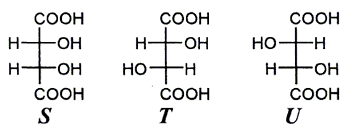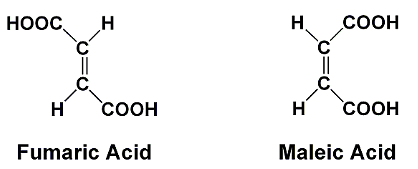JEE Exam > JEE Questions > Directions: The following question is based ...
Start Learning for Free
Directions: The following question is based on the paragraph given below.
P and Q are isomers of dicarboxylic acid C4H4O4. Both decolorise Br2/H2O. On heating, P forms the cyclic anhydride. Upon treatment with dilute alkaline KMnO4, P as well as Q could produce one or more than one from S, T and U.

The compounds formed from P and Q respectively are:
- a)Optically active S and optically active pair (T, U)
- b)Optically inactive S and optically active pair (T, U)
- c)Optically active pair (T, U) and optically active S
- d)ptically inactive pair (T, U) and optically inactive S
Correct answer is option 'B'. Can you explain this answer?
| FREE This question is part of | Download PDF Attempt this Test |
Most Upvoted Answer
Directions: The following question is based on the paragraph given be...
Since both the dioic acids decolourise Br2/H2O, these are unsaturated dioic acids and display geometrical isomerism.
And also, 'P' forms a cyclic anhydride; therefore, it is a cis isomer.
'P' is maleic acid and 'Q' is fumaric acid.

On treatment with KMnO4 solution, both 'P' and 'Q' form tartaric acid which exists as three stereoisomers: S, T and U.
Maleic acid 'P' yields the meso isomer 'S', which is optically inactive.
Fumaric acid 'Q' yields the optically active isomer (T, U).
Hence, option (2) is correct.
Free Test
FREE
| Start Free Test |
Community Answer
Directions: The following question is based on the paragraph given be...
Since both the dioic acids decolourise Br2/H2O, these are unsaturated dioic acids and display geometrical isomerism.
And also, 'P' forms a cyclic anhydride; therefore, it is a cis isomer.
'P' is maleic acid and 'Q' is fumaric acid.

On treatment with KMnO4 solution, both 'P' and 'Q' form tartaric acid which exists as three stereoisomers: S, T and U.
Maleic acid 'P' yields the meso isomer 'S', which is optically inactive.
Fumaric acid 'Q' yields the optically active isomer (T, U).
Hence, option (2) is correct.
Attention JEE Students!
To make sure you are not studying endlessly, EduRev has designed JEE study material, with Structured Courses, Videos, & Test Series. Plus get personalized analysis, doubt solving and improvement plans to achieve a great score in JEE.

|
Explore Courses for JEE exam
|

|
Similar JEE Doubts
Directions: The following question is based on the paragraph given below.P and Q are isomers of dicarboxylic acid C4H4O4. Both decolorise Br2/H2O. On heating, P forms the cyclic anhydride. Upon treatment with dilute alkaline KMnO4, P as well as Q could produce one or more than one from S, T and U.The compounds formed from P and Q respectively are:a)Optically active S and optically active pair (T, U)b)Optically inactive S and optically active pair (T, U)c)Optically active pair (T, U) and optically active Sd)ptically inactive pair (T, U) and optically inactive SCorrect answer is option 'B'. Can you explain this answer?
Question Description
Directions: The following question is based on the paragraph given below.P and Q are isomers of dicarboxylic acid C4H4O4. Both decolorise Br2/H2O. On heating, P forms the cyclic anhydride. Upon treatment with dilute alkaline KMnO4, P as well as Q could produce one or more than one from S, T and U.The compounds formed from P and Q respectively are:a)Optically active S and optically active pair (T, U)b)Optically inactive S and optically active pair (T, U)c)Optically active pair (T, U) and optically active Sd)ptically inactive pair (T, U) and optically inactive SCorrect answer is option 'B'. Can you explain this answer? for JEE 2024 is part of JEE preparation. The Question and answers have been prepared according to the JEE exam syllabus. Information about Directions: The following question is based on the paragraph given below.P and Q are isomers of dicarboxylic acid C4H4O4. Both decolorise Br2/H2O. On heating, P forms the cyclic anhydride. Upon treatment with dilute alkaline KMnO4, P as well as Q could produce one or more than one from S, T and U.The compounds formed from P and Q respectively are:a)Optically active S and optically active pair (T, U)b)Optically inactive S and optically active pair (T, U)c)Optically active pair (T, U) and optically active Sd)ptically inactive pair (T, U) and optically inactive SCorrect answer is option 'B'. Can you explain this answer? covers all topics & solutions for JEE 2024 Exam. Find important definitions, questions, meanings, examples, exercises and tests below for Directions: The following question is based on the paragraph given below.P and Q are isomers of dicarboxylic acid C4H4O4. Both decolorise Br2/H2O. On heating, P forms the cyclic anhydride. Upon treatment with dilute alkaline KMnO4, P as well as Q could produce one or more than one from S, T and U.The compounds formed from P and Q respectively are:a)Optically active S and optically active pair (T, U)b)Optically inactive S and optically active pair (T, U)c)Optically active pair (T, U) and optically active Sd)ptically inactive pair (T, U) and optically inactive SCorrect answer is option 'B'. Can you explain this answer?.
Directions: The following question is based on the paragraph given below.P and Q are isomers of dicarboxylic acid C4H4O4. Both decolorise Br2/H2O. On heating, P forms the cyclic anhydride. Upon treatment with dilute alkaline KMnO4, P as well as Q could produce one or more than one from S, T and U.The compounds formed from P and Q respectively are:a)Optically active S and optically active pair (T, U)b)Optically inactive S and optically active pair (T, U)c)Optically active pair (T, U) and optically active Sd)ptically inactive pair (T, U) and optically inactive SCorrect answer is option 'B'. Can you explain this answer? for JEE 2024 is part of JEE preparation. The Question and answers have been prepared according to the JEE exam syllabus. Information about Directions: The following question is based on the paragraph given below.P and Q are isomers of dicarboxylic acid C4H4O4. Both decolorise Br2/H2O. On heating, P forms the cyclic anhydride. Upon treatment with dilute alkaline KMnO4, P as well as Q could produce one or more than one from S, T and U.The compounds formed from P and Q respectively are:a)Optically active S and optically active pair (T, U)b)Optically inactive S and optically active pair (T, U)c)Optically active pair (T, U) and optically active Sd)ptically inactive pair (T, U) and optically inactive SCorrect answer is option 'B'. Can you explain this answer? covers all topics & solutions for JEE 2024 Exam. Find important definitions, questions, meanings, examples, exercises and tests below for Directions: The following question is based on the paragraph given below.P and Q are isomers of dicarboxylic acid C4H4O4. Both decolorise Br2/H2O. On heating, P forms the cyclic anhydride. Upon treatment with dilute alkaline KMnO4, P as well as Q could produce one or more than one from S, T and U.The compounds formed from P and Q respectively are:a)Optically active S and optically active pair (T, U)b)Optically inactive S and optically active pair (T, U)c)Optically active pair (T, U) and optically active Sd)ptically inactive pair (T, U) and optically inactive SCorrect answer is option 'B'. Can you explain this answer?.
Solutions for Directions: The following question is based on the paragraph given below.P and Q are isomers of dicarboxylic acid C4H4O4. Both decolorise Br2/H2O. On heating, P forms the cyclic anhydride. Upon treatment with dilute alkaline KMnO4, P as well as Q could produce one or more than one from S, T and U.The compounds formed from P and Q respectively are:a)Optically active S and optically active pair (T, U)b)Optically inactive S and optically active pair (T, U)c)Optically active pair (T, U) and optically active Sd)ptically inactive pair (T, U) and optically inactive SCorrect answer is option 'B'. Can you explain this answer? in English & in Hindi are available as part of our courses for JEE.
Download more important topics, notes, lectures and mock test series for JEE Exam by signing up for free.
Here you can find the meaning of Directions: The following question is based on the paragraph given below.P and Q are isomers of dicarboxylic acid C4H4O4. Both decolorise Br2/H2O. On heating, P forms the cyclic anhydride. Upon treatment with dilute alkaline KMnO4, P as well as Q could produce one or more than one from S, T and U.The compounds formed from P and Q respectively are:a)Optically active S and optically active pair (T, U)b)Optically inactive S and optically active pair (T, U)c)Optically active pair (T, U) and optically active Sd)ptically inactive pair (T, U) and optically inactive SCorrect answer is option 'B'. Can you explain this answer? defined & explained in the simplest way possible. Besides giving the explanation of
Directions: The following question is based on the paragraph given below.P and Q are isomers of dicarboxylic acid C4H4O4. Both decolorise Br2/H2O. On heating, P forms the cyclic anhydride. Upon treatment with dilute alkaline KMnO4, P as well as Q could produce one or more than one from S, T and U.The compounds formed from P and Q respectively are:a)Optically active S and optically active pair (T, U)b)Optically inactive S and optically active pair (T, U)c)Optically active pair (T, U) and optically active Sd)ptically inactive pair (T, U) and optically inactive SCorrect answer is option 'B'. Can you explain this answer?, a detailed solution for Directions: The following question is based on the paragraph given below.P and Q are isomers of dicarboxylic acid C4H4O4. Both decolorise Br2/H2O. On heating, P forms the cyclic anhydride. Upon treatment with dilute alkaline KMnO4, P as well as Q could produce one or more than one from S, T and U.The compounds formed from P and Q respectively are:a)Optically active S and optically active pair (T, U)b)Optically inactive S and optically active pair (T, U)c)Optically active pair (T, U) and optically active Sd)ptically inactive pair (T, U) and optically inactive SCorrect answer is option 'B'. Can you explain this answer? has been provided alongside types of Directions: The following question is based on the paragraph given below.P and Q are isomers of dicarboxylic acid C4H4O4. Both decolorise Br2/H2O. On heating, P forms the cyclic anhydride. Upon treatment with dilute alkaline KMnO4, P as well as Q could produce one or more than one from S, T and U.The compounds formed from P and Q respectively are:a)Optically active S and optically active pair (T, U)b)Optically inactive S and optically active pair (T, U)c)Optically active pair (T, U) and optically active Sd)ptically inactive pair (T, U) and optically inactive SCorrect answer is option 'B'. Can you explain this answer? theory, EduRev gives you an
ample number of questions to practice Directions: The following question is based on the paragraph given below.P and Q are isomers of dicarboxylic acid C4H4O4. Both decolorise Br2/H2O. On heating, P forms the cyclic anhydride. Upon treatment with dilute alkaline KMnO4, P as well as Q could produce one or more than one from S, T and U.The compounds formed from P and Q respectively are:a)Optically active S and optically active pair (T, U)b)Optically inactive S and optically active pair (T, U)c)Optically active pair (T, U) and optically active Sd)ptically inactive pair (T, U) and optically inactive SCorrect answer is option 'B'. Can you explain this answer? tests, examples and also practice JEE tests.

|
Explore Courses for JEE exam
|

|
Suggested Free Tests
Signup for Free!
Signup to see your scores go up within 7 days! Learn & Practice with 1000+ FREE Notes, Videos & Tests.
























